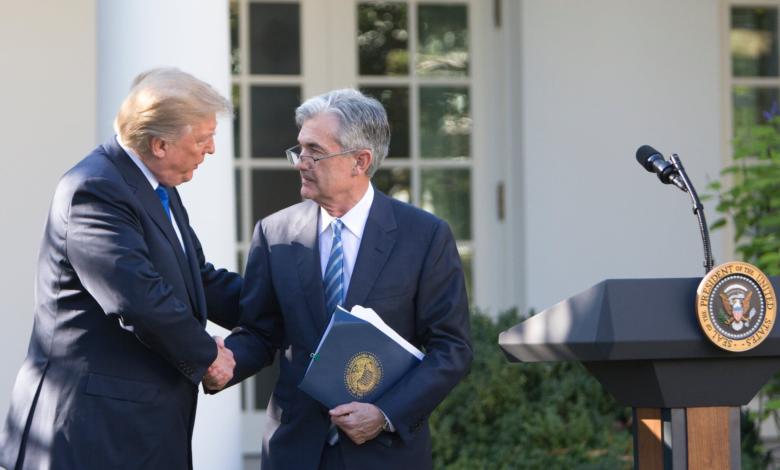Trump Fed Interest Rates: Calls for Cuts to Support Tariffs

Trump Fed interest rates are a focal point of economic discussion as President Donald Trump advocates for significant cuts to bolster his tariff-driven economic strategy. Following an initial phase of restraint from influencing the Federal Reserve, Trump is now pushing for a proactive approach to interest rates amidst his administration’s evolving trade policies. By proposing lower rates, he aims to provide a cushion for American businesses facing the impact of his tariffs, which could inadvertently ignite inflationary pressures. As financial markets speculate on potential interest rate cuts by the Fed, the intersection of Trump’s tariffs and Federal Reserve policy becomes increasingly relevant to investors and economists alike. The debate centers on whether these cuts will effectively reduce inflation and facilitate a smoother economic transition for the country.
In the current economic landscape, President Trump emphasizes the importance of adjusting interest rates as part of his broader financial reforms, particularly in relation to his tariff initiatives. This discussion revolves around the Federal Reserve’s ability to adapt its monetary policy in response to external pressures, making it a critical player in managing the nation’s economic trajectory. With the possibility of interest rate adjustments, the administration seeks to leverage these changes to stimulate growth while navigating the challenges posed by tariffs. This approach underscores the significance of balancing trade and monetary strategies as the economy transitions through these tumultuous changes. Ultimately, the dialogue surrounding Trump’s proposed interest rate adjustments reflects a delicate interplay between fiscal policies and market stability.
The Impact of Trump’s Tariffs on Economic Policy
President Trump’s tariffs are designed to shield American industries from foreign competition but are also creating ripples across the economy. As his administration pushes for aggressive trade measures, the implications for the Federal Reserve’s monetary policy become increasingly significant. With tariffs effectively raising the cost of imports, their impact on consumer prices stands to manipulate inflation rates, potentially undermining the economic stability that lower interest rates aim to promote.
In this context, the Federal Reserve faces a pivotal challenge: how to balance its dual mandate of promoting maximum employment while stabilizing prices. The trade policies could lead to increased costs for consumers, pushing the Fed to consider rate cuts to foster economic resilience. However, there’s a fine line to tread, as the combination of tariffs and rate reductions might inadvertently lead to higher inflation in the short term.
Frequently Asked Questions
How do Trump tariffs influence Federal Reserve policy on interest rates?
Trump tariffs can significantly influence Federal Reserve policy, especially with regard to interest rates. As tariffs are implemented and their effects on the economy unfold, President Trump has suggested that the Fed should cut interest rates to mitigate any adverse economic impacts. Lower interest rates can help stimulate growth, especially during economic transitions caused by tariffs. However, these cuts may also lead to increased inflation, which complicates the Fed’s decision-making process.
What is Trump’s stance on Federal Reserve interest rate cuts in relation to tariffs?
President Trump has been vocal about his desire for the Federal Reserve to cut interest rates as he implements tariffs on imports. By advocating for lower rates, Trump believes it would ease the economic transition linked to his tariff initiatives, making borrowing cheaper and potentially stimulating economic activity. Nevertheless, economists warn that such moves might stir inflation, counterbalancing the potential benefits of lower rates.
Can interest rate cuts by the Fed reduce inflation during Trump’s tariff phase?
Interest rate cuts by the Federal Reserve may not directly reduce inflation, especially during Trump’s tariff phase. While lower rates typically stimulate economic activity, they can also contribute to rising prices when combined with tariffs. As businesses pass on costs from tariffs to consumers, the overall effect can lead to inflationary pressures, even with lower interest rates in place.
How might the Federal Reserve respond to Trump’s tariff policies and interest rate requests?
The Federal Reserve’s response to Trump’s tariff policies and his requests for rate cuts will depend on various economic indicators. While Trump advocates for cuts to support economic growth during tariff transitions, the Fed, led by Chair Jerome Powell, might proceed cautiously, weighing potential inflation risks against the need for economic stimulus. Their decisions will reflect an assessment of the economic landscape and the actual impacts of tariffs on inflation and growth.
What are the expected outcomes of interest rate cuts in the context of Trump’s economic policies?
Expected outcomes of interest rate cuts in the context of Trump’s economic policies, particularly his tariffs, include potential stimulation of economic growth and increased consumer spending. However, there is also a risk that these cuts could contribute to inflation if tariffs lead to higher costs for goods and services. The Fed’s ability to balance these opposing forces will be crucial in determining the overall effectiveness of rate reductions during this phase.
What impact does the Federal Reserve’s policy on interest rates have on Trump’s tariff strategy?
The Federal Reserve’s policy on interest rates significantly impacts Trump’s tariff strategy. If the Fed lowers interest rates as Trump advocates, it may provide an economic cushion during the implementation of tariffs, potentially allowing businesses and consumers to borrow more affordably. However, this could also lead to increased inflation, which would complicate the economic climate that Trump’s tariffs aim to address.
| Key Point | Details |
|---|---|
| Trump’s Position | Trump is urging the Fed to cut interest rates to support his tariff strategies. |
| Impact of Cutting Rates | Lower rates could lead to more inflation combined with tariffs, but they may also support economic stability. |
| Fed’s Response | The Federal Open Market Committee decided to maintain rates but indicated potential cuts later in the year. |
| Market Expectations | Markets anticipate that the Fed will not cut rates until June 2025. |
| Trump’s History with the Fed | Previously, Trump criticized the Fed for raising rates, but has been less vocal in this term. |
Summary
Trump Fed interest rates are a significant topic in the current economic climate, particularly as President Donald Trump calls for the Federal Reserve to cut rates to mitigate the impacts of his tariffs. His push for lower rates aims to ease the transition of tariffs into the economy, although this strategy poses risks of heightened inflation. As the markets watch closely, the Fed’s cautious stance suggests cuts may not materialize until mid-year, raising questions about the balance between tariff impacts and monetary policy.



